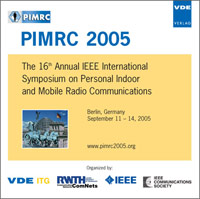Spectrum Efficiency Evaluation for different Wireless Technologies based on Traffic Modeling
Conference: PIMRC 2005 - 16th Annual IEEE International Symposium on Personal Indoor and Mobile Radio Communications
09/11/2005 - 09/14/2005 at Berlin, Germany
Proceedings: PIMRC 2005
Pages: 7Language: englishTyp: PDF
Personal VDE Members are entitled to a 10% discount on this title
Authors:
Ball, C. F.; Humburg, E.; Ivanov, K. (Siemens AG, Communications Mobile Networks, St.-Martin-Str. 76, 81541 Munich, Germany)
Abstract:
Channel capacity and spectrum efficiency are widely used to compare the performance of different wireless technologies in cellular packet data networks. Recent studies revealed strong impact of traffic modeling on these key performance indicators. In this paper two generic traffic models are used to evaluate the spectrum efficiency for widespread GSM/EDGE and the upcoming new broadband OFDM IEEE 802.16 WiMax system. The first traffic model assumes an equal mean packet data call duration (EMPC-D) whereas the second one assumes an equal mean packet call data volume (EMPC-V) per subscriber. The evaluation procedure is based on a newly proposed combined analytical/geometric approach for rapid performance estimation in cellular packet data networks. The results obtained from the derived analytical formulas have been verified and confirmed by numerical computations and detailed system level simulations. The study of GSM/EDGE and mobile WiMax in 1x3 reuse as well as WiMax applied to fixed broadband wireless access (BWA) in 1x1 reuse shows a considerable difference of 40% to 60% in terms of spectrum efficiency between both traffic models. The comparison of mobile WiMax with GSM/EDGE reveals a moderate performance advantage for the new broadband OFDM system in the order of 20%-40% higher spectrum efficiency. BWA WiMax, however, provides a three-fold capacity gain compared to mobile WiMax.


